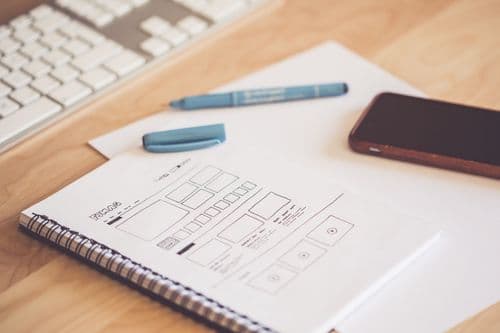From Idea to Launch: The 7 Phases of Web Development

Building a website requires several steps to bring the site from idea to launch. And to make the website development flow easily and pain-free as possible, it must go through the following seven phases:
- Information gathering
- Planning and strategy
- Creating wireframes and prototypes
- Making content
- Development
- Testing and quality assurance
- Deployment and maintenance
Let’s get started reviewing what is done in each phase:
Phase 1: Requirement Gathering

In this phase, the foundation of the project is established. It is where the client talks about the website’s purpose, the target market it will serve, and the features needed to achieve its goals.
Website’s Purpose
The website’s purpose must be discussed to make the project point in the right direction. Here, the client expresses what to accomplish with the website, as well as considers if the website will be an informational, e-commerce, or subscription website.
Target Audience
The website visitors come from different backgrounds, ages, and interests. Will the content of the website be more appropriate for young people? Will the website resonate more with small business owners? Figuring out the audience will make the website convert more efficiently visitors into leads.
Features
The client and the web development team will work together to determine the specific features and functionality the website needs. For example, this may include the ability to sell products, publish articles and news on a blog, collect visitors' information or contact details, and other functionality that would make the website achieve its goal and meet its target market’s needs.
Phase 2: Planning and Strategy

This phase is where the project's scope gets developed and all the website’s requirements for building the entire website. This phase will include establishing the sitemap, the programming technologies, the budget, and the project's timeline.
Sitemap
The sitemap will represent the structure and organization of a website; It will show the hierarchical relationship between pages and the pages it needs to fulfill its goals. Also, a sitemap will make the rest of the phases easier.
Programming Technologies
The best programming technologies that fit the website's end goals will allow it to grow over time. Decisions such as which technology to use are based on what the project demands. There are a lot of programming technologies (also known as development stack) to choose from. Below there is a table showing the most popular combinations:
| Development Stacks | Description |
|---|---|
| MERN | Uses Mongo DB, Express.js, React.js, and Node.js |
| MEAN | Uses Mongo DB, Express.js, Angular 2+, and Node.js |
| MEVN | Uses Mongo DB, Express.js, Vue, and Node.js |
| .NET Framework | Uses the .NET Framework (C#) as backend, with front-end frameworks such as Angular, Vue, or React. |
| Ruby on Rails | Uses Ruby on rails for back-end and front-end. |
| LAMP | Uses Linux, Apache, MySQL, and PHP |
Budget and Timeline
After considering the previous points, a budget and timeline can be made after all research has been done. This step is where the development team can write a proposal to let the clients know how much it will be for the project and the timeline for the delivery. When both parties agree, then it is time for the next phase.
Phase 3: Wireframe and Prototypes

The design process will focus on the look and feel of the project. It involves creating wireframes and prototypes.
Wireframes
The wireframe outline the layout and the content of the project. It is a low-fidelity blueprint of your website. If the content is unavailable, the development teams might provide placeholder content that clients can replace later.
Prototypes
The prototype is the complete representation of the finished project; It includes the colors, effects, and design elements the project will contain. Also, it is where the functionality’s concept and the user experience can be demonstrated. The client’s feedback is needed to move forward to the final version of the prototype.
Phase 4: Content Creation

Like I mentioned before some development teams can use placeholder content after the wireframe is completed, and they can include content writing or copywriting in their services. If not, the client has to provide the content to include in the website by writing themselves, or by hiring a content writer or copywriter. Content creation is an important step for attracting the right audience and increasing the likelihood to bring visitors to the website.
Target Audience
The target audience will be the one to take most of the benefit of the content provided by the website. Learning about what the target audience like to consume and using the right tone and style for your content is key to keeping them coming back for more.
Search Engine Optimization (SEO)
Creating content also increases your SEO to attract more visitors to your website when they do search queries on search engines like Google, Yahoo, Bing, etc. The content must use the right keywords to attract your target audience. With good SEO, the website’s traffic will increase, more visitors can turn into clients, and your website will gain more visibility.
Phase 5: Development

The development phase can start as soon as the design phase is done, but only if the website uses placeholder content to make the project move forward until the content is provided. In this phase, the mockup will be brought to life using the development stack chosen in the planning strategy phase. Taking the sitemap as a guideline to develop the pages. The development phase is broken into two parts: Front-end and back-end development.
Front-end Development
Front-end development is about bringing everything the mock-up does into code using technology such as HTML, CSS, and Javascript. The front end is in charge of everything the user sees and interacts with within the project.
Back-end Development
Back-end development is about all the functionality the user doesn’t see, like all the business logic, managing data in the database, uploading and fetching files and data security.
Phase 6: Testing and Quality Assurance

After development, every project component must be tested to check that everything is doing what it is supposed to do so that the project can come into production with no errors. The tests have to check for pages, features, and different devices' screens.
Pages and Features
All pages must be tested to check if it provides the right content. The features must be thoroughly tested to meet the client's expectations. The test could be done using unit testing and integration testing.
Test on different screens and browsers
Is the website looking good on a mobile, tablet, or big screen? The responsive layout must be tested on different screens to provide the best user experience for visitors from other mediums. Also, the website must be tried on each major web browser to ensure the code is compatible.
Phase 7: Deployment and Maintainance

The last stage is where the project is wrapped up and ready to host the website on a server. After the project is deployed, the project's development comes to an end, but the ongoing maintenance is next. The website will need to periodically backup, improve the website from users' feedback, and scale the server hardware when required.
Making the website public
The final step is making the website reachable to visitors. Next, it will be tested for the last time to ensure everything works in production. After the project gets the green light in every test, the project comes to an end.
Maintaining the website
As the website grows, it will need improvement over time; it will start getting more traffic, visitors’ will provide feedback for improvements, and analytics will provide statistics of your website’s performance. New features need to be developed as the customer base grows. Also, the website needs backups periodically to not lost data in case of hardware failures.
The development team can charge a monthly subscription for maintaining the website or hand all the server credentials to the client.
Conclusion
In conclusion, the development of a project can be done efficiently when a framework is used. With these seven steps, a project can get from idea to launch. Taking the requirement for the project, planning the best strategy to move forward, creating a design that appeals to your visitors, writing content for the users to consume, developing the website with code, testing the code to work on different devices, and deploying and maintaining.
I hope this guide provides what can be expected from building a website at each stage. And if you're a developer, to give you ideas to structure your workflow.
More Posts You Might Like

How to Build a Website for your Small Business
5 Minutes Read
Every company needs a website to attract visitors and have a web presence. Learn how to build a website and what is required to have one running.

The 5 Most Used Types of Business Websites. Which Is The Best Fit For You?
3 Minutes Read
Learn about the five most used types of websites to build for your business.
